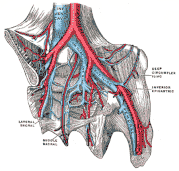|
In the US, approximately 200,000 people are diagnosed with a new or recurrent pulmonary embolism each year. More than twice this many are diagnosed with a DVT without PE, and 1 in 300 ER patients are diagnosed with a DVT. The lifetime risk of a DVT is 2-5%, and the incidence of DVT increases with age. DVTs can lead to a pulmonary embolism, which is one of the leading causes of sudden, nontraumatic death in the US. Most DVTs are unprovoked, with an increased risk for reoccurrence, requiring a longer treatment period than those with provoked DVTs from drugs, trauma, or surgery. Typically, DVTs begin at the valves of the veins. Proximal DVT include Femoropopliteal (FP) ilieofemoral (IF) DVTs, and account for 80% of symptomatic DVTs. Distal DVTs of the calf account for only 20% of symptomatic DVTs. DiagnosisA DVT typically presents with unilateral pain and swelling of a lower extremity, but patients may also complain of cramping or pain with use. Lower DVTs are more likely to be associated with thrombophlebitis. An upper-extremity may present similarly to cellulitis, and those with long-term catheters, such as PICC lines, are at increased risk. Finger swelling or cellulitic-like changes may suggest an upper-extremity DVT.
Patients with a positive d dimer and negative US should have repeat US testing within the next week. TreatmentPatients with DVT require systemic anticoagulation, with either heparin or low molecular weight heparin, while rivaroxaban can be used in many cases, it is not approved for DVTs in the setting of cancer. Those with renal disease should be put on heparin or LMWH. Treatment of isolated calf thrombosis has no set guidelines; some recommend no treatment with followup imaging, while others recommend outpatient LMWH. Indications for Admission of DVT
ComplicationsPost-thrombotic Syndrome (PTS) occurs in 25-50% of patients with proximal DVTs and develops over months to years after a DVT, manifesting with swelling, erythema, and pain. This is due to the scaring and sclerosis of valves, leading to poor function. Skin thickening and recurrent DVTs may occur. Compression stocks can reduce the incidence, however there is low compliance with therapy.
Phlegmasia Cerulea Dolens: A rare complete, extensive venous occlusion of the leg, with severe pain, edema, and cyanosis. Despite intervention, there is a high risk of PE, as well as gangrene of the foot. May Thurner Syndrome: Left iliac vein compression by the iliac artery, leading to large femoral DVTs and requiring surgical intervention and endovascular catheter-directed lysis, aspiration, and angioplasty.
0 Comments
Leave a Reply. |
Categories
Archive
February 2018
Please read our Terms of Use.
|

